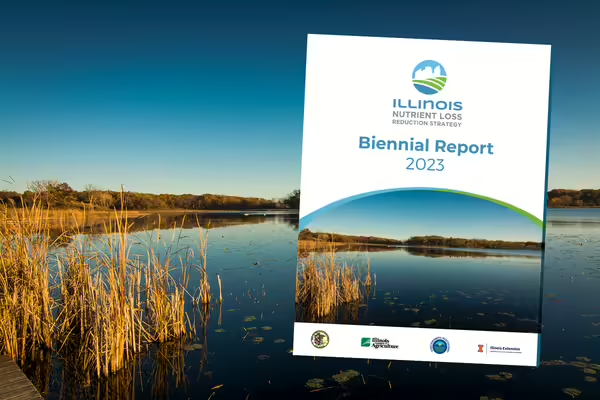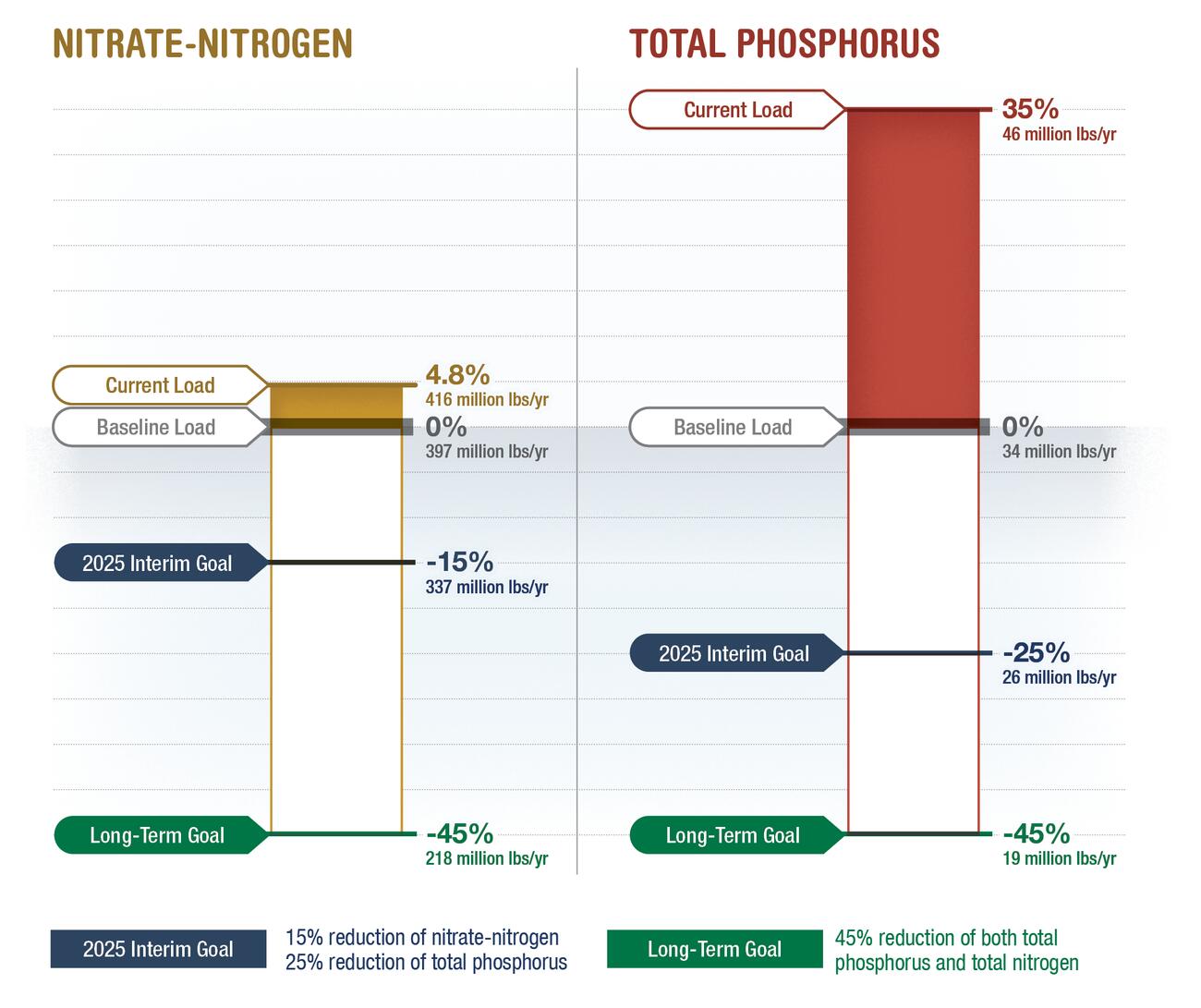
URBANA, Ill. — The loss of nutrients into Illinois’ lakes, streams, and rivers harms water quality here and downstream all the way to the Gulf of Mexico. The Illinois Nutrient Loss Reduction Strategy, NLRS, was established in 2015 and is designed to reduce nutrient pollution in Illinois’ waterways and the Mississippi River and its negative impacts by exploring and recommending practical, research-based nutrient loss practices and collaborating with partners across the state.
The 2023 NLRS Biennial Report, now available at go.illinois.edu/NLRS, is the latest update to the strategy. It documents water quality updates and initiatives for 2021–22 that reduce the loss of the nutrients nitrogen and phosphorus across three sectors: agricultural, wastewater treatment facilities, and urban stormwater. The report also stresses the multifaceted challenges of confronting increasing nutrient loads in Illinois waterways.
The results of water quality measures taken in 2021-22 are mixed. While wastewater treatment facilities successfully reduced their total phosphorus discharges by 6.2 million pounds, or 34%, compared to the 1980-96 baseline measurements, nutrient levels in the state's waterways have continued their upward trend. The five-year average nutrient loads from 2017-21 show that nitrogen increased by 4.8% from baseline to 416 million pounds annually and total phosphorus increased by 35% to 46 million pounds annually. The primary goal of the strategy is a 45% reduction in both nitrogen and total phosphorus loads, with interim targets set at a 15% nitrate-nitrogen decrease and a 25% total phosphorus decrease by 2025.
A variety of factors contribute to rising nutrient loads, including increased streamflow, residual nutrients, nutrient management practices, and some unidentified sources. The impacts of climate change, particularly increased runoff and drainage, intensify river loads and more proactive measures are needed to achieve the strategy’s water quality goals.
Nutrient pollution promotes algal growth and impairs local ecosystems, making water unsuitable for drinking, recreation, fishing, and aquatic life. Excess nutrients also contribute to the “dead zone” in the Gulf of Mexico where aquatic life struggles due to depleted oxygen levels. Illinois is one of 12 states with nutrient strategies that are members of the U.S. Environmental Protection Agency Hypoxia Task Force created to address the issue. The NLRS is a collaborative effort involving the Illinois Environmental Protection Agency, Illinois Department of Agriculture, University of Illinois Extension, stakeholders, and experts from industry, science, and technology.
Nutrient pollution comes from a variety of sources. In Illinois, the agriculture, wastewater treatment, and urban stormwater sectors all have crucial roles and unique challenges in reducing nutrient loss. The levels of nitrogen and phosphorus attributed to each sector vary and were published in the original strategy released in 2015. Fertilizer is the primary source of nutrient loss from agricultural production. Wastewater treatment facility discharge and urban stormwater runoff also contribute to nutrient loss.
The 2023 Biennial Report is the fourth update to the strategy since its inception in 2015. Implementation of the NLRS is guided by research to optimize nutrient loss reduction while fostering deep collaboration and innovation across academia, the private sector, non-profits, wastewater agencies, and local, state, and federal government agencies.
“Our partnership with NLRS allows University of Illinois’ esteemed research scientists and outreach educators to engage with industry experts and agricultural producers across the state, all in the pursuit of enhancing the health of our waterways,” said Shibu Kar, Illinois Extension assistant dean and program leader for natural resources, environment, and energy. “The findings in this report underscore the need to deepen our understanding of nutrient dynamics.”
The 2023 Biennial Report outlines work done by NLRS partners across the state to mitigate nutrient loss through 78 distinct nutrient loss reduction programs and projects, including community outreach and engagement. University of Illinois Extension watershed outreach staff work with farm communities in priority areas to facilitate their engagement in watershed planning and to encourage farmers and landowners to put practices into place that reduce nutrient loss, such as growing cover crops or installing bioreactors to filter water running off farm fields.
“Illinois Extension’s longstanding ties with farming communities across the state through our local county offices allow us to continue to advocate for the adoption of research-based land management practices that farmers can trust as they steward their lands and our waterways,” said Travis Burke, Illinois Extension assistant dean and program leader for agriculture and agri-business. “The widespread adoption of soil and water conservation practices will be crucial to our continued success as an agricultural state.”
Illinois Extension also has rainfall management staff and programs aimed at reducing nutrient loss in the urban stormwater sector by managing runoff and reducing the duration and intensity of flooding. The stormwater sector continues to provide public education on nutrient loss reduction, including the new website, IllinoisGroundwork, which provides information on green infrastructure research, tools, and resources.
Despite the ongoing implementation of nutrient loss reduction practices by each sector, challenges remain. The next Biennial Report will be published in 2025, which marks a decade since the strategy’s inception. Given the current rate of progress, the 2025 goals may not be achieved. More work is needed to encourage widespread adoption of agricultural conservation practices and foster deeper community engagement at the watershed level. Continued support for research, conservation initiatives, and education is essential.
The 2023 NLRS Biennial Report and an executive summary synopsis of the report are available at go.illinois.edu/NLRS. Print copies of the report and executive summary are available upon request to NLRS@illinois.edu.
The annual NLRS Partnership Conference on January 25, 2024, in Springfield will explore the report and other elements of the strategy, including future developments. The conference, which also has an online attendance option, is open to partnerships, stakeholders, and the public who are interested in reducing nutrient loss in Illinois. Visit the NLRS event registration website to sign up.
Photo: Lake Defiance at Moraine Hills State Park. By Holly Hudson, Chicago Metropolitan Agency for Planning.
Media Inquiries: Photos and illustrations related to this report are available for media download. For media interviews, contact Dolan Klein at dolank@illinois.edu or (217) 333-7958.
Illinois Extension leads public outreach for University of Illinois by translating research into action plans that allow Illinois families, businesses, and community leaders to solve problems, make informed decisions, and adapt to changes and opportunities. Illinois Extension is part of the University of Illinois Urbana-Champaign College of Agricultural, Consumer and Environmental Sciences.
